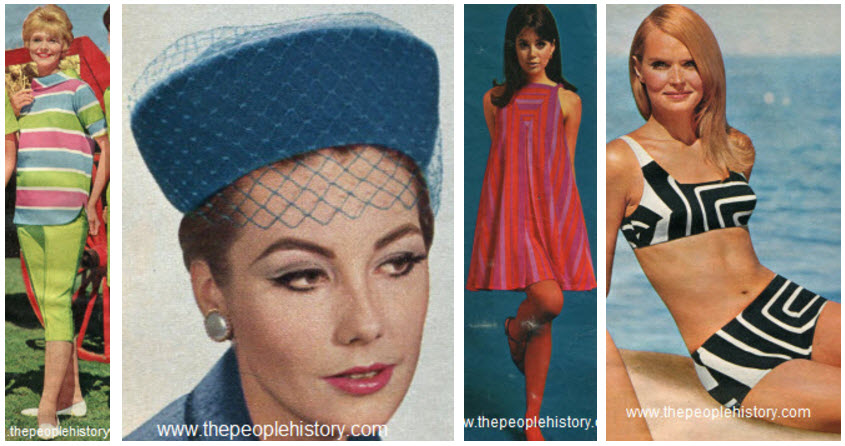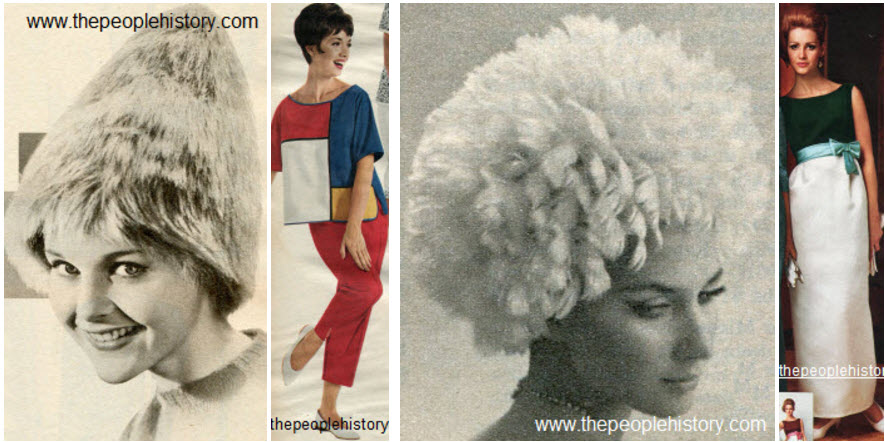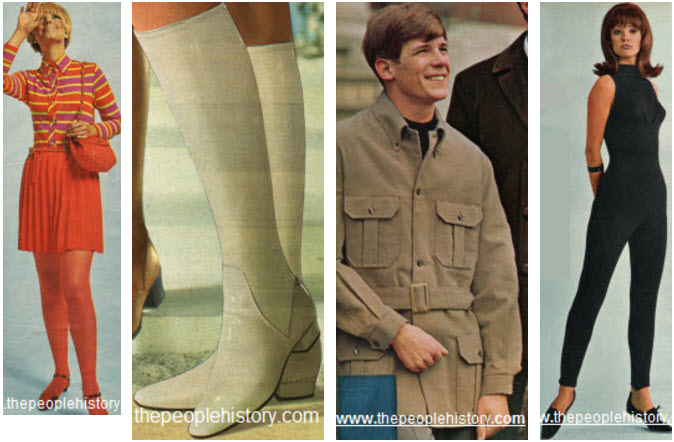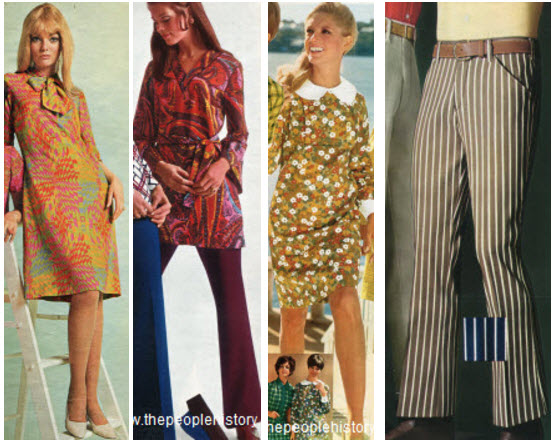Fashion and Hairstyles in the 1960s
Fashion Through The Decades
xx'south Fashions - l'south Fashions - 60'due south Fashions - 70's Fashions - 80's Fashions - Clothes and Fashions Home
Men's, ladies and childrens fashions in the 1960's including prices
Cultural Changes in Society and Their Effect on Style
Style and Accessories of the 1960'south
During the sixties, the economic boom that began during the previous decade continued for the most part. With more people benefiting from prosperity and the civilization moving further away from the thought of post-war rationing, the way a lot of people interacted with fashion began to change. Less people needed to, or even wanted to make their ain clothes and the emergence of even more commercial fashion opportunities meant that using clothing equally a status symbol was no longer confined to the wealthiest. Fashion could now be used to distinguish between levels within the middle grade and even inside the poorest classes in the United States.

Culture and social club also became more casual. Much of the article of clothing could straddle the line between formal and casual and habiliment could be mixed and matched to brand many different outfits for different occasions. Many more outfits began to characteristic slimmer and sleeker lines with A-line and shift dresses existence amongst the about popular fashions for women and tapered dress shirts being popular with men. Along with a more modern look, people took way cues from prominent figures in politics (Jackie Kennedy and the pillbox hat) to entertainment (Cher with long blackness pilus and bong-bottoms). What was acceptable in terms of personal style changed quickly and often. Hemlines of skirts rose college for women, hair length grew longer on men, and 2 piece bikinis became common pond attire. If fashion of the 1950s first inspired individual identity through way, the sixties fully embraced and encouraged it.
Fashion and the Influence of Music and Telly
Although it was invented much earlier, television ruled the 1960'south. Equally technological advances made manufacturing easier and cheaper, and as the middle class and dispensable income grew, there was a precipitous rise in the number of households that owned a telly. This had a major influence on what people were exposed to (including way trends), as they could see what was going on in the fashion earth through their favorite goggle box personalities and past seeing their favorite musicians perform on television. Not merely did Tv shows influence the popular fashion trends of the time, simply television commercials and an increased endeavour on marketing towards youth added to the importance of staying in style and cultivating an individual fashion sense. Idiot box had helped to create a new fashion-consciousness that could connect viewers to the hither and now. People had ever taken style cues from entertainment like films, but tv connected people to style on a daily basis and served as a bridge between generations, regions, and classes in a way no other technology had been able to before.

Music became important to the fashions of the 1960s, too. Many of the most popular genres were associated with specific fashion trends that emerged at the same time; Mod to British Invasion, Hippies to Psychedelic and Folk rock, and then on. Music fans took fashion cues from their favorite artists in the aforementioned way Goggle box viewers looked for trends in their almost loved programs. Waves of similarly dressed people would show upwards at concerts and festivals, bonding in the commonality of their private mode sense. Television besides helped to spread the latest style trends through music as there were many programs dedicated to showcasing the nigh current and pop performers playing their almost recent songs.
Modernistic and the London Look
Modern mode came out of the youth subculture popularized in Great U.k. during the 1960s. Mods in Britain were all about way and it was on the beginning modernistic cultural movements to emphasize special fashions for men and normalize men's involvement in current fashions. Modernistic way was connected to specific designers similar Mary Quant who can be credited with popularizing the mini-brim (a fashion must-have for any Mod woman). These fashion trends started in London and were particularly represented on Carnaby Street. The look was not confined to certain elements but did place emphasis on bright, assuming patterns and colors, jackets for men, go-go boots, and shorter skirts and hairstyles for women. The style strayed from its original lifestyle associations and took on a more trendy tone as it moved from the U.k. to the US with the British musical invasion. Every bit a reaction to the Modern-look there were others who rejected that specific style and embraced the rock 'n' scroll reverse to the mods. "Rockers" in Britain and "Greasers" and "Jocks" in the Us rejected this fashion and rebelled in their fashion choices by focusing on leather and jeans or a look rooted in athletics and a clean-cut style. Mod fashion reached the height of its popularity during the early to mid-sixties and was in decline by 1966 and 1967, making room for other style trends to take over.

Hippie Fashion and the Counterculture
At the contrary end of the consumer way spectrum from the Mods were the Hippies and their unique way. The hippie counterculture emerged from the West Coast civilization of the United States and spread throughout the country from the mid-sixties onward. The Haight-Ashbury area in San Francisco and Greenwich Hamlet in New York City were hot spots for Hippie fashions in detail. The style became more represented in mainstream civilization later 1967'south "Summer of Beloved" and the look was pop from that point on until the mid-seventies. Hippie fashion represented a rebellion against consumerism and the clothes and accessories were ofttimes handmade or purchased from flea markets. The style featured long "maxi" skirts, bong-bottomed jeans, flowing cloth tops, peasant blouses, paisleys, florals, bright tie-dyes, and Eastern, Indian, Native American, and African motifs. Sandals were the footwear of choice for men and women and long hair was encouraged. The conventional rules for presenting oneself were wholly shunned and men sported long, unkempt beards with their long hair. Hippie women rejected make-up and revolted against the restricting shape-wear garments like girdles, padded bras, nylons and controllers that had been considered the norm for the previous decades. Overall the the fashion of the hippie counterculture demonstrated what they considered to exist a more natural wait that looked to turn pre-conceived notions around and have the mainstream civilisation questioning their own fashion rules.

High Fashion: Models and Designers
High fashion in the sixties was nothing without the iconic models that showed off new styles and inspired some designers and artists likewise. In the opinion of some, many of the first models to be considered "supermodels" came out of this decade and many others however reached levels international acclaim. Some examples of famous models from the 1960s include Twiggy, Lauren Hutton, Jean Shrimpton, and Naomi Sims. Jean Shrimpton and Twiggy could be considered two of the world's beginning supermodels and Naomi Sims is oftentimes considered the world's first African American supermodel, while Lauren Hutton turned her modeling into an acting career. One of the almost important mode faces to come up out of the sixties has to be Twiggy, whose thin and boyish trunk, cropped androgynous hair and massive eyelashes made her a fashion icon in London and internationally. Twiggy's thin trunk and short hair were perfect for designers to try new androgynous and slimmer styles of article of clothing. Unfortunately, many believe this alter in fashion and the emphasis on extreme thinness was acquired by extremely thin models that came out of the decade and new manner of clothes fabricated to fit a thinner frame and that it all contributed to an increase of body prototype issues and eating disorders for youth since then. Some of the virtually famous fashion designers that rose to prominence in the sixties were Yves Saint Laurent, Mary Quant, Oscar de la Renta, and Emilio Pucci.
More Sixties Mode Pages -- Sixties Shoes and Hats -- Sixties Dresses -- Sixties Kids Clothes -- Sixties Mens Fashions
1960'southward Habiliment Price List
1960's Price List
Dyed Squirrel Stoles
$135.00 New York 1967
Easter Bonnets From $3.95 to $12.95 Wisconsin 1963
Fur Trimmed New Flavour Coats from $58.00 to $88.00 New York 1967
Gabardine Bomber Jackets $10.98 Ohio 1962
Ladies Stretch Pants $vi.99 California 1961
Ladies Swimsuits From $three.99 to $19.99 California 1961
Men's Chukka Boots $one.99 New Jersey 1956
Men'due south conform, $68.00 New Jersey 1956
Men'southward marathon hat $vii.95 Wisconsin 1963
Men'due south Ties 50 cents Massachusetts 1965
Mink Fur Trim Coat $69.00 Massachusetts 1965
Misses Swinging Shifts Skirts $5.00 New York 1967
Oxford men's Shoes $12.95 New York 1967
Run Proof Nylons $1.15 Ohio 1962
Short Sleeve Dress Shirt $5.95 Washington 1964
Stay press ladies Slacks $2.50 New York 1967
Women'southward adapt $15.90 New Jersey 1966
Youths Rubber Boots $4.98 Massachusetts 1965
Men'south Polyester Suits $39.50 Kansas 1964
Boys' slacks From $1.99 New Jersey 1966
Corduroy Shirts $3.99 Ohio 1962
0 Response to "Fashion and Hairstyles in the 1960s"
Post a Comment